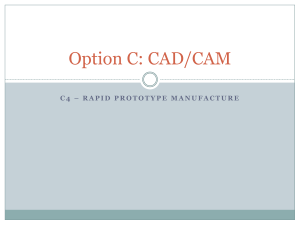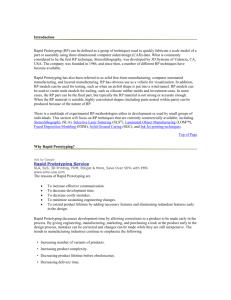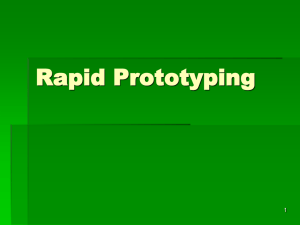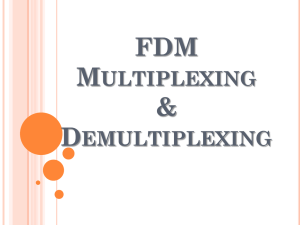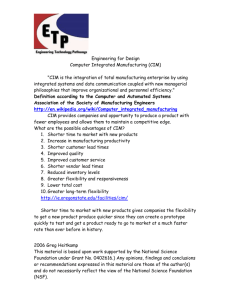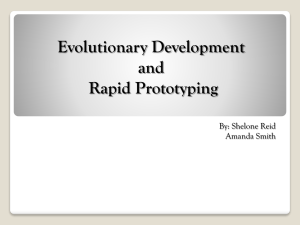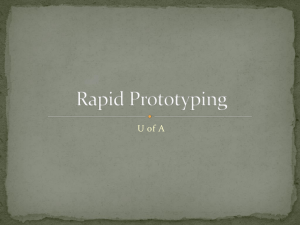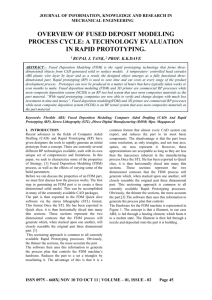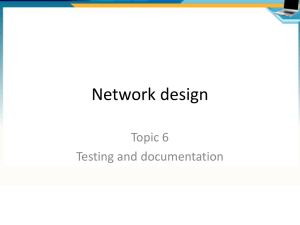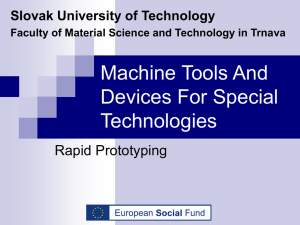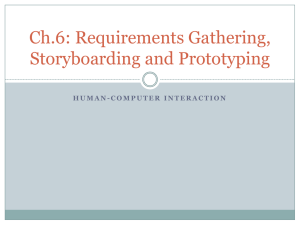Advanced Manufacturing Choices
advertisement
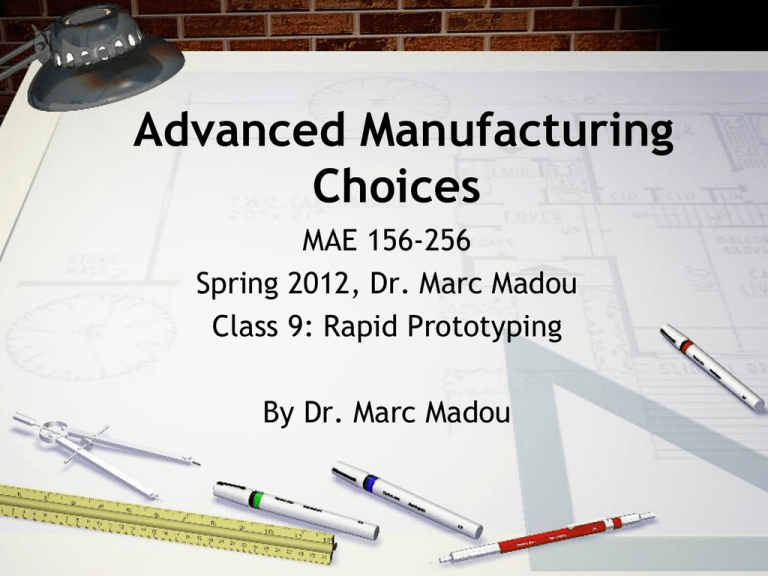
Advanced Manufacturing Choices MAE 156-256 Spring 2012, Dr. Marc Madou Class 9: Rapid Prototyping By Dr. Marc Madou Two Ways for Fabrication: Subtractive manufacturing Additive Manufacturing Rapid Prototyping • Some other names: – Additive manufacturing – Computer controlled moldless additive manufacturing • Part is produced by producing multiple “slices” i.e. cross sections • From 3D model [STL file (see next slide)] to physical object, with a “click” – Layered manufacturing – Rapid prototyping: • Variety of methods: more and more functional products rather than just prototypes STL File* • The STL (stereo lithography) file format is supported by many other software packages; it is widely used for rapid prototyping and computeraided manufacturing (CAM). STL files describe only the surface geometry of a three dimensional object without any representation of color, texture or other common CAD model attributes. *An STL file describes a raw unstructured triangulated surface by the unit normal and vertices (ordered by the right-hand rule) of the triangles using a three-dimensional Cartesian coordinate system. Basic Principles of Rapid Prototyping Rapid Prototyping • • • • 3d model generated Sliced Each slice manufactured and layers are fused together A voxel (volumetric pixel or, more correctly, Volumetric Picture Element) is a volume element, representing a value on a regular grid in three dimensional space. This is analogous to a pixel, which represents 2D image data in a bitmap (which is sometimes referred to as a pixmap). Materials For Rapid Prototyping • Materials covered: – – – – – Thermoplastics (FDM, SLS) Thermosets (SLA) Powder based composites (3D printing) Metals (EBM, SLS) Sealant tapes (LOM) Stereolitography (SLA) Selective Laser Sintering (SLS) Fused Deposition Modeling (FDM) Laminated Object Modeling (LOM) 3D Printing Electron Beam Melting (EBM) Examples of Rapid Prototyping Applications: • Prototyping (90 %) – – – – Concept models Architectural models Disney characters Movies—or is that real and thus manufactured? – Etc • Manufacturing (10%) – Implants and custom medical devices – Aerospace parts – Pilot scale production of lab equipment – Molds .. A Stradivarius ? Rapid Prototyping by Industry Sectors: Methods for RP • • • • • • Stereolitography (SLA) Selective Laser Sintering (SLS) Fused Deposition Modeling (FDM) Laminated Object Modeling (LOM) 3D Printing Electron Beam Melting (EBM) Selection of Optimal Process • Functional parts: – FDM (ABS and nylon) – SLS (thermoplastics, metals) – EBM (high strength alloys, Ti, stainless steel, CoCr) • Non functional parts: – SLA: smoothest surface, good for casting – LOM, 3D Printing, marketing and concept protos. Machine Cost Fused Deposition $10/hr Modeler 1600 (FDM) Laminated Object $18/hr Manufacturing (LOM) Sanders Model $3.30/hr Maker 2 (Jet) Selective Laser $44/hr Sintering 2000 (SLS) Stereolithography $33/hr 250 (SLA) Z402 3-D $27.50/hr Modeller (Jet) Rapid Prototyping Response Material Application Time Techniques: 2 weeks ABS or Strong Parts Casting Wax Casting Patterns 1 week Paper (wood- Larger Parts like) Concept Models 5 weeks Wax 1 week Polycarbonat light: 100%; e TrueForm margin: SandForm 0">Casting Patterns Concept Models Epoxy Resin Thin walls (Translucent) Durable Models Starch/Wax Concept Models 2 weeks 1 week Casting Pattern Process: Laminated Object Modeling (LOM) • Object made by deposition and cutting of layers of tapes • Introduced in 1991 by Helisys Inc of Torrance. • Cubic and Helisys offer this technology • Slow, sharp edges • Research on composites prepregnated moldless manufacturing • Inexpensive depending on accuracy, large scale models possible • Slow and inaccurate (knives vs lasers) LOM Objects Fused Deposition Modeling (FDM) • Extruder on a cartesian robot • Extrudes thermoplast polymers “spaghetti” • Moderately fast and inexpensive • Stratasys is the market leader • Functional parts, ABS and nylon • Best choice for mechanical engineers and product developers ! • Can be used for direct digital manufacturing • Systems starting from $14,000 Abbreviation: FDM Material type: Solid (Filaments) Materials: Thermoplastics such as ABS, Polycarbonate, and Polyphenylsulfone; Elastomers Max part size (LxWxH): 36.00 x 24.00 x 36.00 in. Min feature size: 0.005 in. Min layer thickness: 0.0050 in. Accuracy: 0.0050 in. Surface finish: Rough Build speed: Slow FDM Most common FDM Systems • High Res: – Dimension ELITE • Large FootPrint (12x12) – Dimension SST1200 • Low cost – uPrint ($14,900) • Do it Yourself: – FAB@Home – RepRap Stereolitography (SLA) • Patented in 1986 • 3D System is the market leader • Highest resolution and smoothness • UV Laser beam cure cross-sections of parts in a liquid batch of photoreactive resin • Subvariants: DLP entire layer projection Stereolitography (SLA) Selective Laser Sintering (SLS) • Can be used for both thermoplastics and metal • Powder is fed into a continuous layer • Laser is used to fuse/sinter powder particles layer-by-layer • Produces functional parts • Layer thickness 0.004” or less SLS samples 3D Printing • Layer of powder is first spread across build area • Inkjet-like printing of binder over the part cross-section • Repetition of the process with the next layer • Can produce multi-colored parts • Useful only for presentation media • Lowest resolution of all techniques • Market Leader: Z-Corp 3D Printing Electron Beam Melting (EBM) • Dispensed metal powder in layers • Cross-section molten in a high vacuum with a focused electron beam • Process repeated until part is completed • Stainless steel, Titanium, Tungsten parts • Ideal for medical implants and injection molds • Still very expensive process Examples of EBM Do it Yourself FDM rapid prototyping (cost under $5K) • FAB@Home • RepRap The Future ? Self-replication ! RepRap achieved self-replication at 14:00 hours UTC on 29 May 2008 at Bath University in the UK. The machine that did it - RepRap Version 1.0 “Darwin” - can be built now - see the Make RepRap Darwin link there or on the left, and for ways to get the bits and pieces you need, see the Obtaining Parts link. Questions and Answers ? Rapid Prototyping Process Flow • • • • • • • Solid Modelling Tesselation/Generation of STL file Support Generation “Slicing” of the Model Model Physical Buildup Cleanup and Post Curing Surface Finishing
